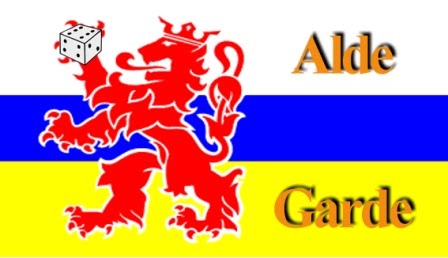Hollandse Garde
Starting with the Hollandse Garde (Dutch Guard) which was in the pay of the province of Holland and its proprietor was the Stadtholder William V of Orange-Nassau.
The regiment was raised in 1599 as a regiment of Nassau, since 1674 a guard regiment and since 1702 called the regiment Hollandse Garde.
Since the reorganisation of 1752, the regiment had 2 battalions each with 6 musketeer companies and one grenadier company although formally there were just 14 companies of which the first two were grenadier and the other twelve musketeers. The grenadiercompanies (as in all Dutch infantry regiments) were also referred as Lijfcompagnieën (Life companies)
Regarding its flag; in 1786 the existing flags were under pressure of the then ruling Patriots changed as these didn't like the Orangist heraldric signs which were on the flags.
As with the help of an invading Prussian army the patriots were chased out of Holland in 1787,the Orangists became the ruling class again which resulted in 1788 in new flags (with orangist heraldic signs of course ) for the Hollandse Garde.
The patriot-period colonels flag looked like this (from the Rijksmuseum Amsterdam):
The front side shows the same arrangements only the middle oval is the weapon of Holland (red lion on gold background). I don't have a coloured image of that side but will try to get it.
The right one is 117*97 cm with also as background colour ecru. Again, the backside is the same as the frontside.
As the design of the post 1788 regimental flag isn't known, I would suggest for now, the same design for both flags, just different background colour.
Notice that the bag of the grenadierbeasrkin is red; the same as the colour of the facings.
The drummers wore the following:
Zwitserse Garde
The Zwitserse garde (Swiss guard) was raised from various Swiss companies in the service of the Dutch State in 1749 although various Swiss regiments were already in the service of the Dutch Republic for a long time.
In the budget of 1792 the regiment is mentioned as consisting of one battalion of 8 strong companies but probably these would be used as two battalions, each of four companies.
All Swiss regiments had no seperate grenadier companies but grenadiers were integral to each company but probably in the field were used as an separate company.
The first company of the regiment was called the lijf company or Prinzen Compagnie as the Prinz of Orange (The Stadtholder) was its inhaber and owner of the first company.
Each company had its own flag (so in total eight flags were carries but the first company had the white colonelsflag and the 7 other companies had an regimental one.



























1 comment:
That's a fine collection of prints.
Regards, James
Post a Comment